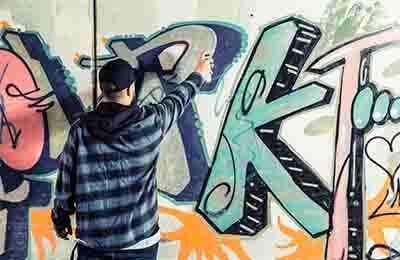涂鸦,另类的艺术?
时间:2022-10-15 12:37:56

Graffiti
Graffiti is defined as a type of deliberate marking made by humans on property. It can take the form of writing, drawings or symbols. The exact origin of the word 'graffiti' is disputed. One theory is that it is derived from the Italian word 'graffiato', which means 'to scratch'. Before the advent of spray cans most graffiti was scratched onto surfaces. Another likely theory is that it originates from the Greek word 'graphein', which means 'to write'.
Ancient Graffiti
Graffiti existed in ancient times. Inscriptions on public property without the permission of the government were common in the ancient civilizations of Egypt, Greece and Rome. The best preserved examples exist in Pompeii and reflect the street life of that city before its destruction. Pompeii's graffiti includes insults, love declarations, and political satire. Tourists to the ancient city of Ephesus, in Greece, will be shown ancient graffiti advertising prostitution. It consists of a hand, a heart and a number. Local tour guides explain that the heart represents love, the number refers to the amount of steps to be taken to get there and the hand indicates that payment will be necessary.
'Kilroy Was Here'
One of the most famous graffiti trends in history began to appear in the U.S., Europe and Australia at the time of the Second World War. It consisted of a face with a large nose peeking over a wall. A caption underneath would read, 'Kilroy Was Here'. Sometimes the name was different. In Britain, it was often 'Chad' and in Australia 'Foo' was popular. Furthermore in Britain, a line satirizing the lack of commodities due to rationing would be included. This usually took the form of 'What, no (name of commodity)?'
Theories to how this trend started and spread are so many that there are several books written on the subject. One theory suggests that Kilroy was an American Navy shipyard inspector. He would write his name on the pieces of equipment he had inspected. Thousands of servicemen saw the name 'Kilroy' in the most unusual places, (e.g. the inner hull section of a destroyer) and would then write 'Kilroy Was Here' wherever they were stationed during the war. A myth developed about the ability of Kilroy to be everywhere. Other theories include that Kilroy was a time traveller from the future who returned to witness historical events.
Tagging
In post-war Europe and America, large scale urbanisation led to an increase in gang rivalries. Gangs would define their territories by marking symbols or words on public areas in their neighbourhoods. This became known as 'tagging'.
Today, tagging is not confined to gangs. Many taggers merely want to have their name seen. This has led to huge competitions between different taggers. In many cases they will try to better each other by having their name or symbol sprayed in more difficult places. Having your symbol in a difficult to reach place, such as a bridge, is known as 'tagging heaven's place'. The deepest insult that one tagger can give another is to 'line' his 'tag', which is done by drawing a line through it. When a tagger becomes well known, he is said to be 'up'. The primary target for taggers in New York is the subway system. Taggers can become 'up' if they manage to tag the inside and outside of every train in the system. This is referred to as 'going all city'.
In other cases, tagging is used to commemorate an event, such as a death, or to express respect for the tagger's idols. When famous rappers, like Tupac Shakur, have died, numerous tags mourning their passing appeared in urban areas in the U.S. Some of these have been so creative and elaborate that shop owners decided not to remove them from their premises. The Abbey Road Studio in London has received Beatles related graffiti in different languages since the band first recorded there. Not only does the studio not discourage this but actually has the wall repainted occasionally to allow a fresh surface for more inscriptions.
Modern taggers are eager to differentiate themselves from gang taggers. They emphasize that their purpose is self-expression and has nothing to do with the criminal activities of gangs.
Art or Vandalism?
Despite the influence of graffiti on mainstream art and fashion, it is
still illegal almost everywhere in the West. In recent years, some major cities in North America and Europe have launched anti-graffiti campaigns. Critics of graffiti claim that its associations with urban decay and gang related crime cause it to make urban areas look poor and dangerous.
Nonetheless, some graffiti works are so creative that it has to be admitted that the 'writers' have artistic talent. In some cases a 'crew' will work together to cover an entire wall with a complex design or picture. This is known as 'bombing'. Supporters of graffiti say that these kinds of artists are talented people who, without graffiti, would not have the opportunity to express themselves. Moreover, without the commercial or political pressures of mainstream art, graffiti is a true form of free expression. However, graffiti is usually written on property which does not belong to the writer, making it an illegal act.
Some cities have tried to find a compromise by providing areas for graffiti crews to practice legally. They hope that this will give talented people in urban areas a channel to express themselves. They also claim that because the graffiti artists can work legally in these allocated areas they can take more time to their pieces and, therefore, produce better quality works. Some graffiti artists have entered the mainstream art world and have been hired by corporations for advertising campaigns.
涂鸦
涂鸦被释为一种在财物上肆意进行刻画的人为活动。它可以采用文字、涂绘或符号的形式。对于“graffiti(涂鸦)”这个词的真正来源,存在争议。一种说法是,它从意为“乱写”的意大利词语“graffiato”衍生而来。在喷雾罐出现以前,大多数的涂鸦都是被乱涂到物体表面上的。另一种可能的说法是,它源于意为“书写”的希腊词语“graphein”。
古代涂鸦
涂鸦在古代就有。在埃及、希腊和罗马等古代文明中,未经政府许可就在公共财产上进行铭刻是司空见惯的。在庞贝就保存着最好的实例,它们反映了这座城市在毁灭前的市井生活。庞贝的涂鸦包括侮辱言辞、爱情宣言和政治嘲讽。前往希腊以弗所市的游客会被领去参观为卖春活动做广告的古代涂鸦。该涂鸦由一只手、一颗心和一个数字组成。当地的导游解释说,心代表爱、数字指代需要走多少步就可以到达那里,而手则表示必须要付钱。
基尔罗伊到此一游
历史上最著名的涂鸦风潮之一,始于二战时期的美国、欧洲和澳大利亚。它由一张趴在墙上进行窥视的脸构成,脸上有一个大大的鼻子。底下的文字常常是“基尔罗伊到此一游”。有时,名字会有所不同。在英国,经常是用“查德”,而在澳大利亚,流行用“福”。而且,在英国,还常会用到一句话,对由定量配给造成的商品短缺状况进行嘲讽。而这句话通常采用的形式是“什么,没有(+商品名)?”。
对于这一风潮是如何开始并传播的说法有很多,以至于出现了多本著作论述这一课题。一种说法是,基尔罗伊是美国海军造船场的检查员。他会在其检测过的那些装备上写下自己的名字。数以千计的军人在那些最特别的地方看到了“基尔罗伊”这个名字(如驱逐舰的船体内侧部分),随后就会在战争期间在他们驻守过的所有地方都写下“基尔罗伊到此一游”。一个关于基尔罗伊具有无处不在的能力的神话便流传开来。其它的说法还包括,基尔罗伊是一名来自未来的时空旅行者,为了见证历史事件而折返回来。
留名
在战后的欧洲和美国,大规模的城市化进程导致了帮派争斗的增多。而帮派会在其所在地区的公共场合刻画符号或文字,以此来划分他们的地盘。这被称为“留名”。
今天,“留名”并非仅为帮派所用。许多“留名者”只是想让其名讳被看到而已。这导致了在不同“留名者”中间出现了巨大的竞争态势。在许多情况下,他们会试图把他们的名字或符号喷涂在更有难度的地方,以此来互相比拼。把你的名字弄到一个难以够到的地方,如一座桥上,就被叫做“在天堂留名”。一个“留名者”可以给另一个“留名者”的最大侮辱就是把他的“留名”给“划掉”,其做法就是在它上面划一道线。当一个“留名者”声名大噪之后,他就被认为是“扬名”了。在纽约,“留名者”的首要目标是地铁系统。如果“留名者”设法在整个系统里所有列车的内部和外部都“留名”,那他们可能就“扬名”了。而这被称为“全市游走”。
在其它情况下,“留名”被用来纪念某人过世之类的事件,或是表达对“留名者”的偶像的敬意。在那些著名说唱歌手,如图帕克・沙克,去世时,在美国许多都市地区都出现了无数“留名”,对他们的过世表示哀悼。其中有一些是非常有创造力和精细复杂的,以至于店主决定不把它们从其房屋上抹掉。自从甲克虫乐队在“修道院路录音棚”进行了首次录音之后,那里就出现了很多与该乐队相关的、用多种语言写成的涂鸦。这家录音棚不仅不对此事加以阻拦,竟然还会不时重新粉刷墙壁,以便为铭刻活动提供新壁面。
现代的“留名者”渴望将自己与“帮派留名者”区分开来。他们强调说,其目的是自我表达,与帮派犯罪活动毫无瓜葛。
是艺术还是破坏?
尽管涂鸦对主流艺术和时尚有影响,但几乎在整个西方,它仍旧是非法的。近些年来,北美和欧洲的一些主要城市发起了反涂鸦运动。对涂鸦持批评态度的人宣称,它与都市衰败现象和相关帮派犯罪活动有联系,从而使都市地区看起来贫穷而又危险。
然而,一些涂鸦作品是非常有创造力的,以至于不得不承认“作者”是有艺术天分的。在有些情况下,一个“团队”会通力合作,用一个复杂的图案或绘画来覆盖整个墙壁。这被称为“轰炸”。支持涂鸦的人说,这类艺术家是有才华的人,是那类不去涂鸦就没有展示他们自己的机会的人。此外,没有了主流艺术所面临的商业或政治上的压力,涂鸦就是一个真正的自由表达方式。然而,涂鸦通常是涂写在不属于作者的财产上,从而使其成为一种非法行为。
一些城市为涂鸦团体提供了一个合法的练习场地,以此来尝试寻找一个折中的方法。他们希望这样可以为都市地区有才华的人们开辟一个展示自己的渠道。他们还声称,由于涂鸦艺术家可以在这些指定区域合法工作,他们可以把更多的时间花在他们的作品上,因此创作出质量更加上乘的作品。有一些涂鸦艺术家已经进入了主流艺术界,并受雇于公司负责广告活动。
graffiti /`Gr9`f1ti/ n.在墙壁等上的涂抹乱写
deliberate /di`lib9reit/ adj.故意的
property /`pr4p9ti/ n.财产;所有物
dispute /dis`p(t/ v.争论;辩论
advent /`2dv9nt/ n.(尤指不寻常的人或事)出现;到来
inscription /in`skripH9n/ n.题字;碑铭
satire /`s2tiai9/ n.讽刺;讽刺作品
prostitution /,pr4sti`t(H9n/ n.;堕落
caption /`k2pH9n/ n.说明;字幕
satirize /`s2tiraiz/ v.讽刺性描写
ration /`r2H9n/ v.实行定量配给
shipyard /`Hipj3d/ n.造船所
serviceman /`s/vism9n/ n.军人;修护人员
station /`steiH9n/ vt.驻扎;配置
urbanisation /,9b9nai`zeiH9n/ n.都市化
rivalry /`raiv9lri/ n.竞争;敌对状态
confined /k9n`faind/ adj.被限制的;狭窄的
better /`bet9/ vt.超过
commemorate /k9`mem9reit/ vt.纪念
elaborate /i`l2b9r9t/ adj.精心制作的
premise /`premis/ n. (pl) 房屋及其周围的房基地
differentiate /,dif9`renHieit/ v.区别;区分
vandalism /`v1nd9liz(9)m/ n.故意破坏艺术的行为
compromise /`k4mpr9maiz/ n.妥协;折中
obscene /4b`s1n/ adj.的;猥亵的
vulgar /`v7lG9(r)/ adj.粗俗的;庸俗的
shepherd /`Hep9d/ n.牧羊人
